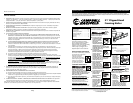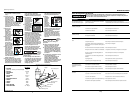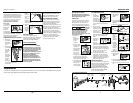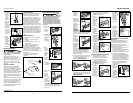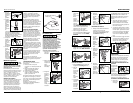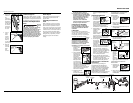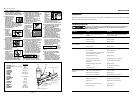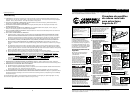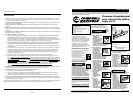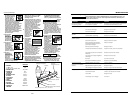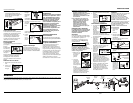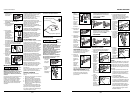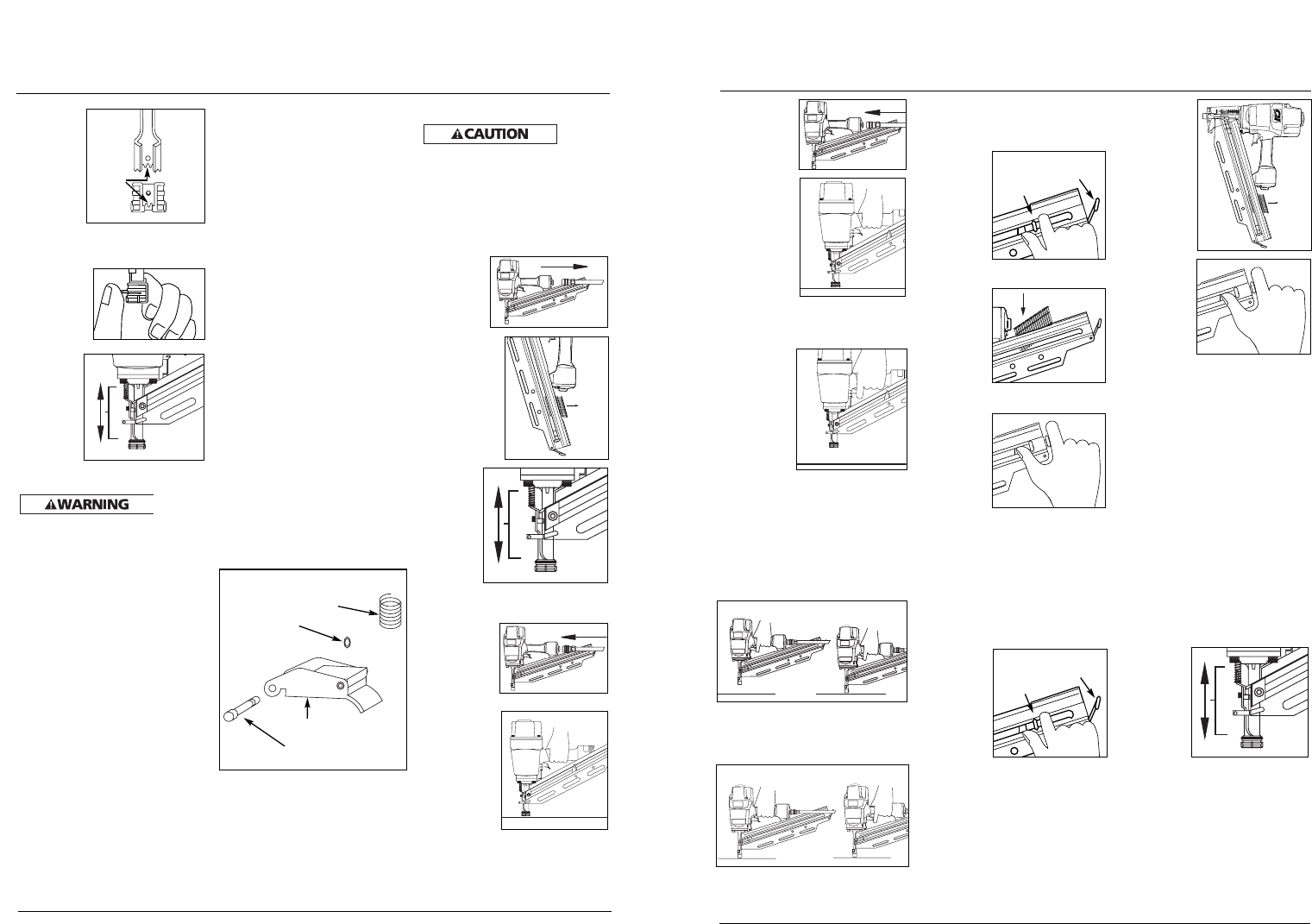
4. Carefully
place no-
mar tip
over the
end of
work
contact
element.
Position
tip onto
WCE
making certain serrated gooves on
each piece are in line and fit snugly
together.
5. Position
retaining
ring on no-
mar tip and
press firmly
in place.
6. Check
that the
WCE and
trigger
move up
and down
freely
without
sticking or
binding.
Operational Modes
Always
know the
operational mode of the nailer before
using. Failure to know the operational
mode could result in death or serious
personal injury.
This stick framing nailer may be
operated in the “Single Cycle” or the
“Bottom Trip” mode. The nailer is
delivered in the single cycle mode. A
separate ‘red’ trigger for “Bottom
Trip” mode is included with tool as an
accessory.
SINGLE CYCLE MODE
When the black trigger is installed,
nailer is in single cycle mode. This
method is recommended when precise
nail placement is required. Operation
in this mode requires trigger to be
pulled each time a nail is driven. Nailer
can be actuated by depressing the
Work Contact Element (WCE) against
work surface followed by pulling the
trigger.
The trigger must be released after each
fastener is driven to allow tool to reset.
Since the tool can only be actuated by
first removing the finger from the
trigger, this is considered to be a more
restrictive mode of operation, suitable
for less experienced users.
WORK CONTACT ELEMENT (WCE)
Check
the
operation of the Work Contact Element
(WCE) trip mechanism before each use.
The WCE must move freely without
binding through its entire travel
distance. The WCE spring must return
the WCE to its fully extended position
after being depressed. Do not operate
the nailer if the WCE trip mechanism is
not operating properly. Personal injury
may occur.
1. Disconnect
the air
supply
from the
nailer.
2. Remove all
nails from the
magazine
(see
Unloading
The Nailer).
3.
Make
sure the
trigger
and work
contact
element
(WCE)
move
freely up
and
down without sticking or binding.
4. Reconnect
air supply to
the nailer.
5. Depress the
Work
Contact
Element
(WCE)
against the
work surface
without
pulling the
trigger. The
nailer MUST NOT OPERATE. Do not
use the tool if it operates without
pulling the trigger. Personal injury
may result.
BOTTOM TRIP MODE
When the red trigger is installed, the
nailer is in bottom trip mode. This
method is recommended when less
precise nail placement is required.
Operation in this mode requires trigger
to be depressed with nailer off of the
work surface. Then, the nose of the
nailer is tapped against the work
surface causing a nail to be driven.
Each time the Work Contact Element is
depressed, a nail is driven into the work
surface. Extreme care should be taken
because a nail will be driven when the
WCE is pressed against any surface.
Since the tool can be actuated without
removing the finger from the trigger,
this is considered to be a less restrictive
mode, suitable for more experienced
users.
MODE CONVERSION
To convert the tool from one mode to
the other:
1. Remove o-ring on the side of
trigger pin.
2. Remove trigger pin, trigger, and
trigger spring.
3. Switch out only the trigger.
4. Replace trigger spring, trigger,
trigger pin, and o-ring.
Do not attempt to modify the trigger
components in any manner and do not
attempt to use any other trigger
components other than those intended
for this tool.
Contact your Campbell Hausfeld
representative if you have any
questions.
Operating Instructions
4
Modelo NS319500
5-Sp
4. Reconectar el
abaste-
cimiento de
aire a la
clavadora.
5. Presione el
elemento de
contacto de
trabajo (WCE)
contra la
superficie de
trabajo sin
tirar del
gatillo. La
clavadora
NODEBE
FUNCIONAR.
No utilice la herramienta si ésta
funciona sin haber tirado del gatillo.
Puede causar lesiones personales.
6. Retire la
clavadora
de la
superficie
de trabajo.
El elemento
de contacto
de trabajo
(WCE) debe
regresar a
su posición
inferior
original. Tire del gatillo. La
clavadora NO DEBE FUNCIONAR.
No utilice la herramienta si ésta
funciona cuando se levanta de la
superficie de trabajo. Puede causar
lesiones personales.
7. Tire del gatillo y presione el elemento
de contacto de trabajo (WCE) contra
la superficie de trabajo. La
clavadora DEBE FUNCIONAR.
8. Presione el elemento de contacto de
trabajo (WCE) contra la superficie de
trabajo. Tire del gatillo. La clavadora
DEBE FUNCIONAR.
CÓMO CARGAR LA CLAVADORA
1. Siempre conecte la herramienta al
abastecimiento de aire antes de
cargar los sujetadores.
2. Jale el
mecanismo
del
empujador
de clavos
hasta que
éste
engrane
con el
enganche
del
cargador.
3. Cargue la
tira de
sujetadores
en la
ranura del
cargador.
Asegúrese
de que los
clavos estén
colocados en la herramienta en la
orientación correcta.
4. Presione el
empujador
con el
enganche
para desen-
ganchar al
empujador.
Asegúrese
de que la
cabeza del último clavo esté debajo
de la cabeza del empujador.
CÓMO DESCARGAR LA CLAVADORA
1. Siempre descargue todos los
sujetadores antes de retirar la
herramienta de funcionamiento.
La acción de descargar es lo
contrario a la de cargar, con la
excepción que siempre debe
desconectarse la manguera de
aire antes de descargar.
2. Jale el
mecanismo
del empu-
jador de
clavos hasta
que el
empujador
se engrane
con el
enganche
del cargador.
3. Sostenga la
herramienta
hacia arriba
para que los
clavos se
deslicen
para atrás
hacia la
ranura del
cargador.
4. Presione el
empujador
con el
enganche
para desen−
ganchar al
empujador
una vez que
se hayan
retirado todos los clavos.
CÓMO AJUSTAR LA PENETRACIÓN
DEL CLAVO
Las clavadoras NS319500 tienen una
característica de profundidad de
accionamiento ajustable. Esto permite
que el usuario determine qué tan
profundo se va a introducir un clavo en
la superficie de trabajo.
1. Ajuste la presión de operación a una
presión que accionará
uniformemente a los sujetadores. No
exceda la máxima presión de
operación de la clavadora de 8,27 bar.
2. Para ajustar la profundidad de
accionamiento, afloje el perno de 4
mm que está encima de la nariz. Para
aumentar la profundidad, presione el
elemento de contacto de trabajo
(WCE), hacia la nariz, tanto como lo
desee. Vuelva a ajustar el perno. Para
disminuir la profundidad, retire el
WCE tanto como desee. Vuelva a
ajustar el perno.
3. Asegúrese
de que el
gatillo y el
elemento
de
contacto
de trabajo
(WCE) se
muevan
fácilmente
hacia
arriba y hacia abajo sin pegarse o
atracarse luego de cada ajuste.
El mecanismo
del
empujador
de clavos
El
enganche
El mecanismo
del
empujador
de clavos
El
enganche
Grooves
www.chpower.com
1
2
Mode Conversion
Trigger spring
O-ring
Trigger pin
Trigger
1
2



